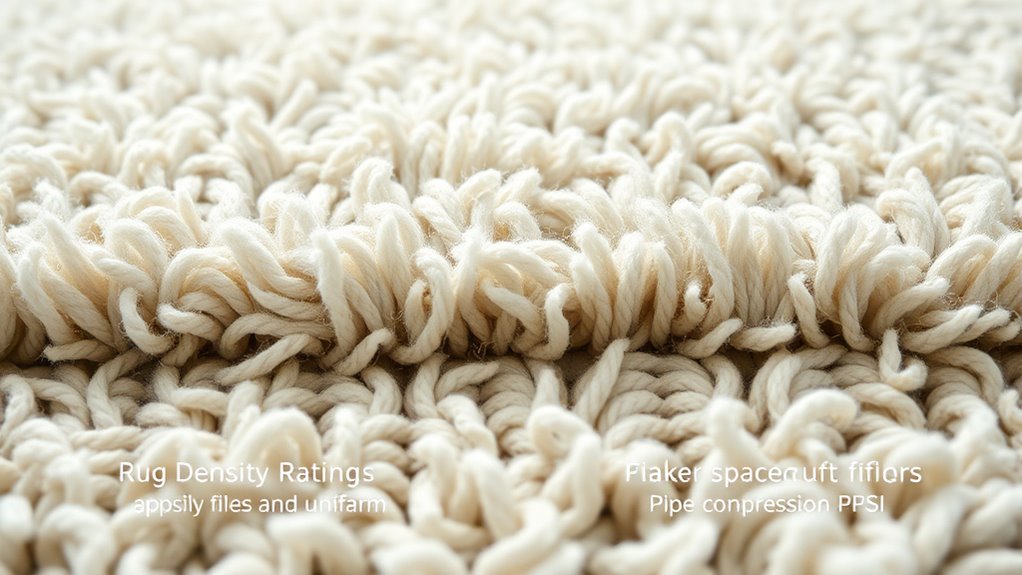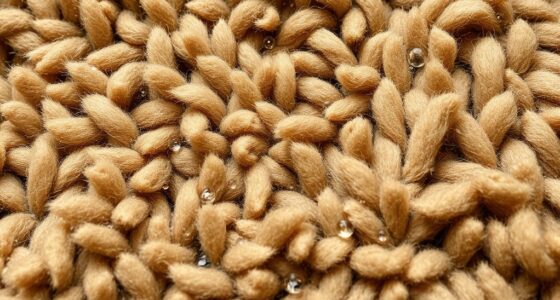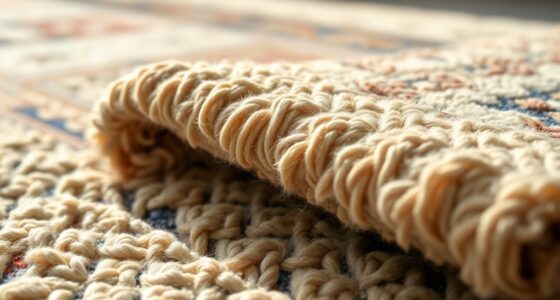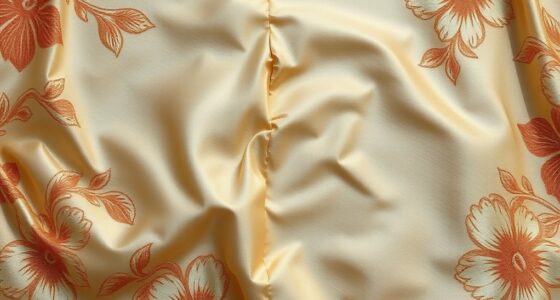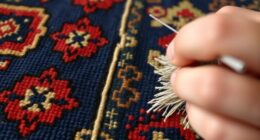Understanding rug density ratings like KPSI and PPSI helps you evaluate a rug’s durability and quality. KPSI measures how many knots there are per square inch, indicating knot density and craftsmanship, while PPSI shows the weave’s tightness or picks per inch. Both impact how long your rug lasts and feels underfoot. To pick the right rug, it’s important to understand how these ratings work, especially if you want more detailed guidance.
Key Takeaways
- KPSI measures knots per square inch, indicating knot density and craftsmanship in woven rugs.
- PPSI assesses picks per square inch, reflecting weave density in rug construction.
- Higher KPSI suggests increased durability and tighter knot packing; higher PPSI indicates a denser weave.
- Both ratings are crucial for evaluating rug quality, durability, and longevity.
- Accurate measurement of KPSI and PPSI helps select rugs suited to specific durability and aesthetic needs.
What Are KPSI and PPSI?

Have you ever wondered how rug quality is measured? KPSI (Knots Per Square Inch) and PPSI (Picks Per Square Inch) are two key metrics. KPSI indicates the density of knots, which depends on fiber types and manufacturing processes. Higher KPSI means more knots packed tightly, often reflecting better craftsmanship and durability. PPSI measures the number of weaves or picks per inch, mainly in woven rugs, showing how densely the fibers are woven. Different fiber types, like wool or silk, affect these ratings because each material has unique properties influencing knot and weave density. Manufacturing processes, such as knotting techniques and weaving methods, directly impact KPSI and PPSI, helping you assess a rug’s quality and longevity. The fiber quality also plays a significant role in determining the overall durability and appearance of the rug. Additionally, understanding manufacturing techniques can provide insights into the rug’s craftsmanship and long-term resilience. Understanding these measurements guides you in choosing a rug that balances beauty and durability, especially considering material density and how it relates to rug lifespan and resilience.
How Rug Density Affects Durability and Comfort
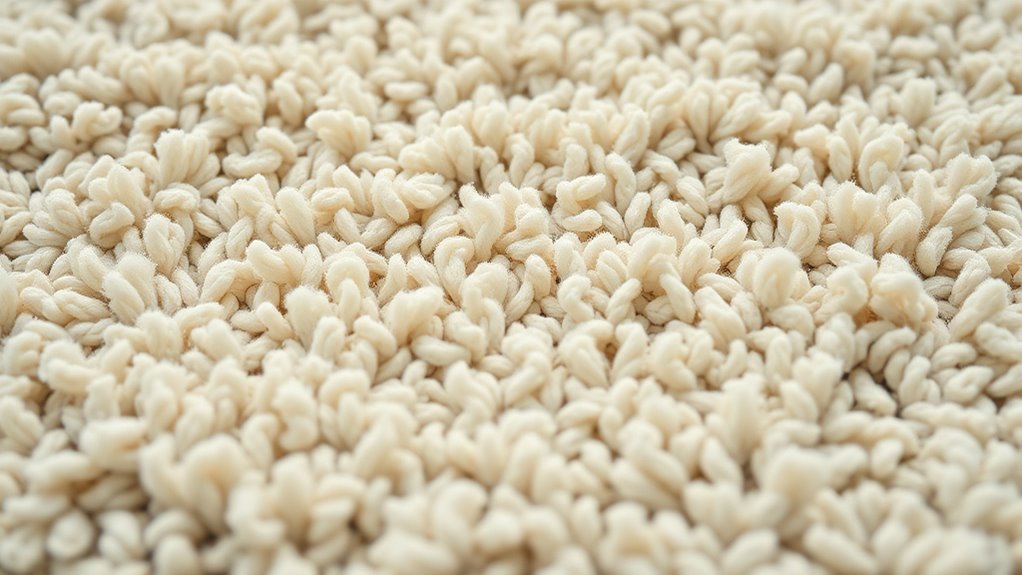
Rug density directly impacts how long your rug lasts and how comfortable it feels underfoot. A denser rug tends to resist wear better and provides a softer, more cushioned surface. Understanding these factors helps you choose a rug that balances durability with comfort for your space.
Durability and Wear
Higher rug density generally means increased durability and resistance to wear, making it a practical choice for high-traffic areas. Dense rugs tend to last longer and withstand daily friction better, ensuring your investment maintains its aesthetic appeal. While a denser rug may feel softer underfoot, it also supports better fiber retention, reducing shedding over time. The fiber quality also plays a significant role in the overall durability of the rug. Additionally, understanding density ratings can help you select the best rug for your specific needs. Keep in mind, though, that very high density can sometimes compromise rug softness if not balanced properly. The table below highlights how density impacts various aspects:
| Density Level | Rug Softness | Wear Resistance | Aesthetic Appeal |
|---|---|---|---|
| Low | Softer | Less durable | Slightly less refined |
| Medium | Balanced | Moderate | Good overall look |
| High | Slightly firmer | Highly durable | Premium appearance |
Comfort and Cushioning
As density increases, rugs tend to feel more supportive and cushioned underfoot, enhancing overall comfort. Higher-density rugs provide a plush, soft feel that makes standing or walking more pleasant, especially in areas where you spend a lot of time. This added cushioning can improve the experience of various area rug styles, from traditional to modern designs. Additionally, a dense rug offers a stable surface that helps prevent slipping and shifting, contributing to a cozy atmosphere. When selecting rugs with different density ratings, you’ll notice a broader range of color options and textures that complement your decor. Ultimately, higher density not only boosts comfort but also allows for more diverse design choices, making your space feel inviting and tailored to your style.
Rug Longevity Factors
While denser rugs often last longer, their durability depends on more than just weight; construction quality and material choice also play crucial roles. The fiber types you choose influence both longevity and aesthetic appeal. Natural fibers like wool are durable and soft, while synthetic options such as nylon offer resilience against wear. Higher density improves durability and comfort, but improper construction can cause premature wear. Consider these factors: rug density ratings provide insight into the expected lifespan and comfort of a rug. Additionally, understanding manufacturing techniques can help you select rugs that maintain their quality over time. Paying attention to material composition can further enhance your selection process by matching the rug’s properties to your specific needs.
Methods for Measuring KPSI and PPSI
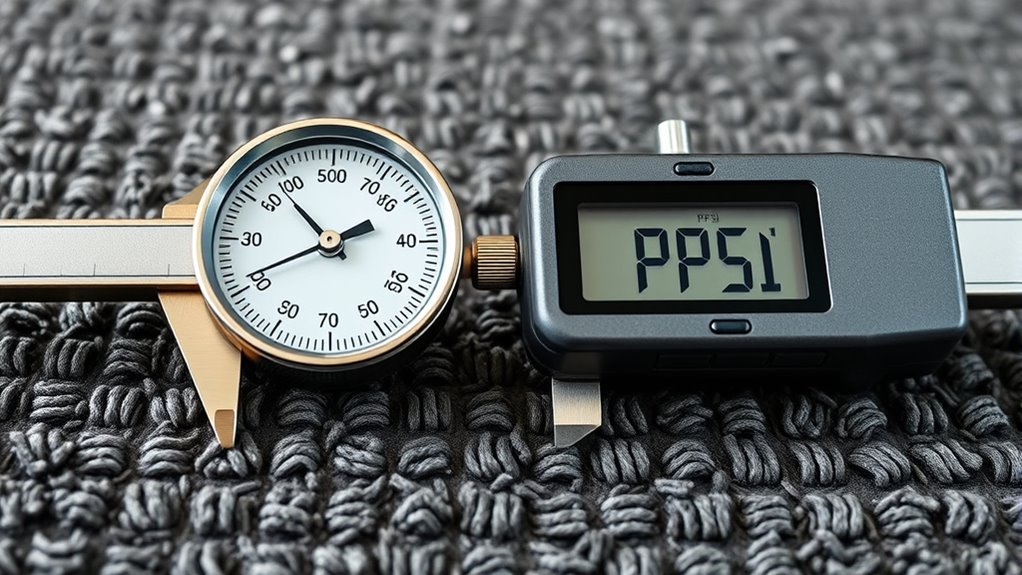
Measuring KPSI (knots per square inch) and PPSI (pounds per square inch) involves specific techniques designed to accurately assess rug density. To determine KPSI, you typically count the number of knots within a defined area, considering the fiber composition and manufacturing processes that influence knot density. A higher KPSI indicates a denser, more durable rug. Knot density plays a crucial role in evaluating rug quality and longevity. Understanding the manufacturing process can further inform how different techniques impact rug density and durability. Additionally, assessing fiber types can provide insights into how the rug will wear over time and its overall quality. PPSI measurement requires applying pressure with a specialized gauge to evaluate how tightly the fibers are packed, reflecting the rug’s overall compactness. Both methods rely on understanding the rug’s construction, including fiber types and weaving techniques. Mastering these measurements can help identify rug density ratings that match your needs for durability and longevity. Precise measurement guarantees you assess rug quality correctly, helping you make informed decisions based on its density, longevity, and structural integrity.
Comparing KPSI and PPSI: Which Matters More?
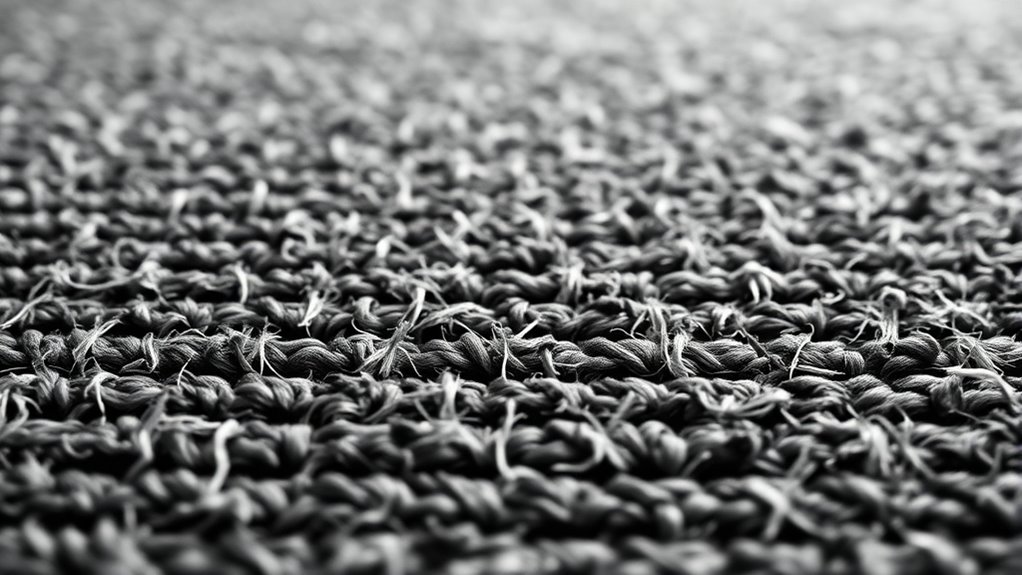
Understanding the differences between KPSI and PPSI helps you determine which measure better indicates rug quality for your needs. KPSI focuses on the density of the fiber pile, which directly impacts the rug’s durability and how it feels underfoot, especially for different fiber types like wool or synthetic fibers. PPSI, on the other hand, measures the backing density, influencing the rug’s stability and overall aesthetic appeal. If you prioritize long-lasting, plush rugs with a luxurious feel, KPSI might matter more. Additionally, considering rug backing materials can further influence your decision based on durability and appearance. Both ratings provide valuable insights, but understanding the specific measures of rug density can help you select a rug that best fits your usage and style preferences. For instance, higher fiber pile density often correlates with increased wear resistance, which is essential for high-traffic areas.
Practical Tips for Evaluating Rug Density When Shopping
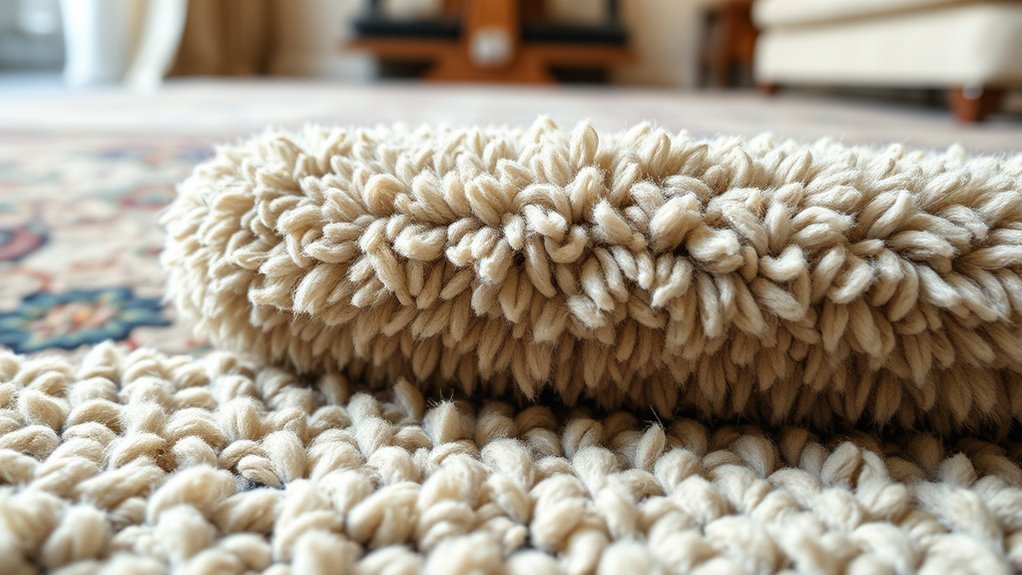
When shopping for a rug, evaluating its density can considerably impact your satisfaction with the purchase. To do this effectively, consider the surface texture—denser rugs often feel plush and luxurious. Also, check the aesthetic appeal; a dense rug typically looks more vibrant and well-crafted. Gently press on different areas to assess firmness and uniformity. Look at the back of the rug; a tightly woven foundation indicates higher density. Use this table as a quick reference:
| Tip | What to Look For | Why It Matters |
|---|---|---|
| Surface Texture | Plush, firm feel | Indicates density and quality |
| Rug Back | Tight, even weave | Reflects overall density |
| Visual Inspection | Consistent pile height | Enhances aesthetic appeal |
Additionally, understanding Rug Density Ratings like KPSI and PPSI can help you make more informed comparisons between different rugs. These ratings are based on the fiber density, which directly influences durability and comfort. For example, higher fiber density often correlates with increased wear resistance, making your rug last longer. Recognizing the significance of rug construction can further enhance your ability to select a durable and attractive rug. These tips help ensure your rug offers durability and beauty.
Common Misconceptions About Rug Density Ratings
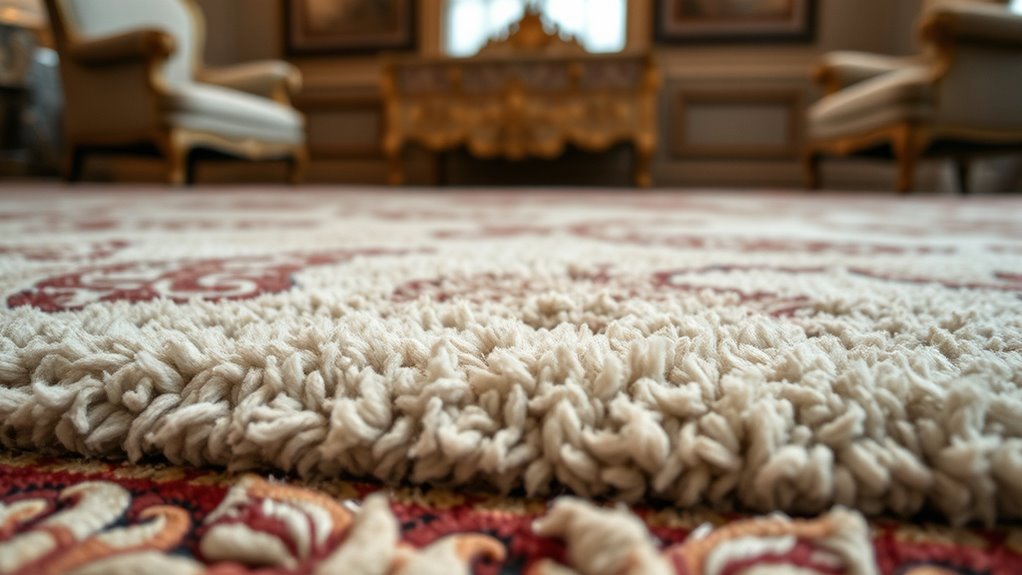
Many people assume that a higher rug density rating always means better quality, but this isn’t necessarily true. While density impacts durability, fiber types play a vital role in determining a rug’s overall performance and look. For example, a dense rug made from synthetic fibers might lack the natural appeal and softness of one crafted from wool or silk. Additionally, some believe that higher density automatically enhances aesthetic appeal, but a rug’s visual charm also depends on design, color, and fiber quality. Overemphasizing density can lead you to overlook these important factors. Remember, a well-balanced rug combines appropriate fiber types with suitable density to guarantee both durability and visual attractiveness, rather than relying solely on density ratings. Vetted fiber quality is essential to achieving the best balance between durability and appearance in a rug. Moreover, understanding rug density ratings can help you make more informed purchasing decisions that suit your needs. When evaluating rugs, considering fiber durability and how well the fibers withstand wear can be just as important as the density rating itself. Additionally, cybersecurity vulnerabilities in manufacturing or retail systems can pose risks when purchasing rugs online, so ensuring secure transactions is also advisable.
How to Choose the Right Rug Based on Density Ratings
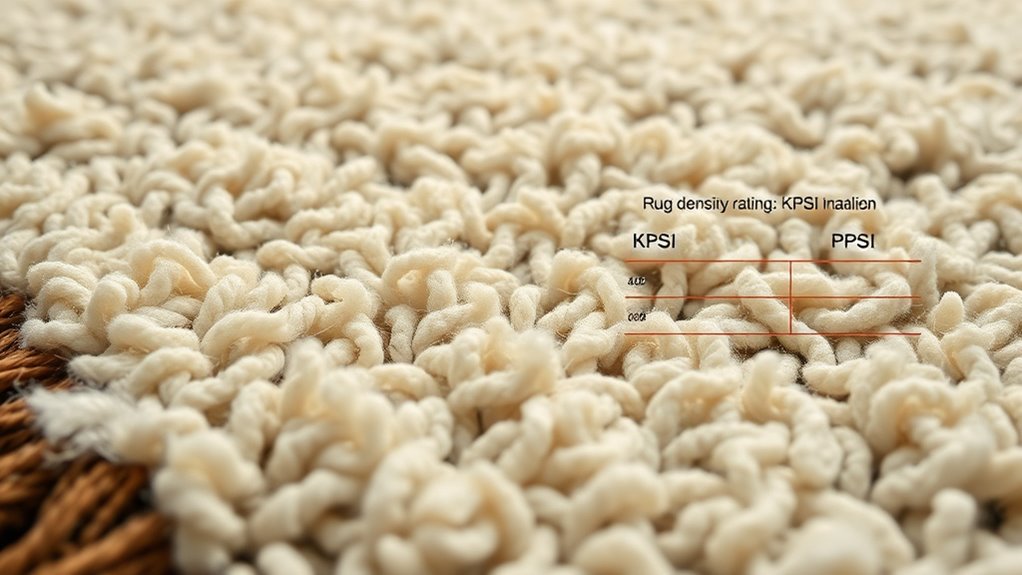
When selecting a rug, think about your room’s traffic and how much wear it will tolerate. High-density rugs are great for busy areas, while lower densities work well for decorative spaces. Consider where you’ll place the rug to guarantee it matches your needs and lasts longer.
Match Room Traffic
Have you ever wondered how to choose a rug that can keep up with your daily traffic? The key is matching your room’s activity level to the rug’s density rating. High-traffic areas, like entryways or living rooms, need rugs with higher KPSI or PPSI to withstand constant foot traffic without showing wear. Consider the color patterns; darker or busier designs hide dirt and stains better, reducing cleaning efforts. For maintenance, use appropriate cleaning techniques suited to your rug’s density—more durable rugs tolerate regular vacuuming and spot cleaning. Lower-density rugs may be better for less busy spaces, where delicate patterns and lighter colors can shine without frequent cleaning. Matching the rug’s density with your room’s traffic ensures longevity, aesthetic appeal, and easier upkeep.
Consider Rug Placement
Choosing the right rug placement starts with understanding how density ratings influence where a rug performs best. Higher density ratings, like KPSI or PPSI, mean the rug is more durable and better suited for high-traffic areas, such as entryways or living rooms. For these spots, opt for rugs with higher density to ensure longevity and withstand frequent use. Conversely, lower density rugs work well in spaces where aesthetic balance matters more than durability, like bedrooms or decorative accents. Consider how the rug fits within your room’s layout and design to create harmony. Proper rug placement not only enhances functionality but also guarantees your space looks cohesive and inviting. Ultimately, matching density ratings with your room’s purpose helps you select the perfect rug for each area.
Frequently Asked Questions
Can Rug Density Ratings Be Trusted Across Different Manufacturers?
You might wonder if rug density ratings are reliable across manufacturers. While these ratings aim to compare quality, manufacturer consistency can vary, and material variance may affect the accuracy. It’s wise to scrutinize each brand’s standards and not rely solely on the numbers. By doing so, you make certain you get a rug that meets your expectations, regardless of differing density ratings from various manufacturers.
How Do Environmental Factors Influence Rug Density Over Time?
Environmental factors can markedly impact your rug’s density over time. Moisture absorption can weaken fibers and cause uneven settling, while UV degradation from sunlight breaks down the material, reducing density. To keep your rug in top shape, protect it from excessive moisture and direct sunlight. Regular maintenance and using UV-resistant treatments help preserve its density, ensuring longevity and continued comfort underfoot.
Are Higher KPSI or PPSI Always Better for Every Room?
You might think higher KPSI or PPSI is always better, but that’s not true for every room. For areas with heavy foot traffic, higher ratings help fiber compression last longer, ensuring durability. However, for comfort and softness, lower ratings may be preferable. Consider manufacturing consistency and how the rug’s density impacts its feel; the best choice depends on your specific needs and space.
Do Rug Density Ratings Affect Allergy Sufferers Differently?
Rug density ratings can impact allergy sufferers differently. Denser rugs tend to trap more dust and allergens, which might worsen allergy triggers if not cleaned regularly. If you’re sensitive to dust accumulation, opt for rugs with moderate density and make certain of frequent vacuuming. Higher density rugs aren’t always better for allergy sufferers; instead, choose a balance that minimizes dust buildup and makes cleaning easier for your health.
Is There a Standard Industry Measurement for Rug Density?
Think of rug density as the heartbeat of comfort; it keeps your space alive. There’s no single industry standard for measuring rug density, but manufacturers often rely on fiber compression and manufacturing standards to gauge quality. These factors influence durability and feel, helping you pick a rug that withstands daily life. While no universal measurement exists, understanding these elements helps you choose rugs that truly match your needs.
Conclusion
Ultimately, understanding rug density ratings helps you pick a durable, comfortable rug. Think of it like choosing between a plush, cozy blanket and a rugged, resilient mat—each suited for different needs. While high KPSI or PPSI might promise lasting quality, comfort and style matter too. By balancing these factors, you create a space that feels both inviting and built to last, transforming your room into a perfect blend of strength and softness.
